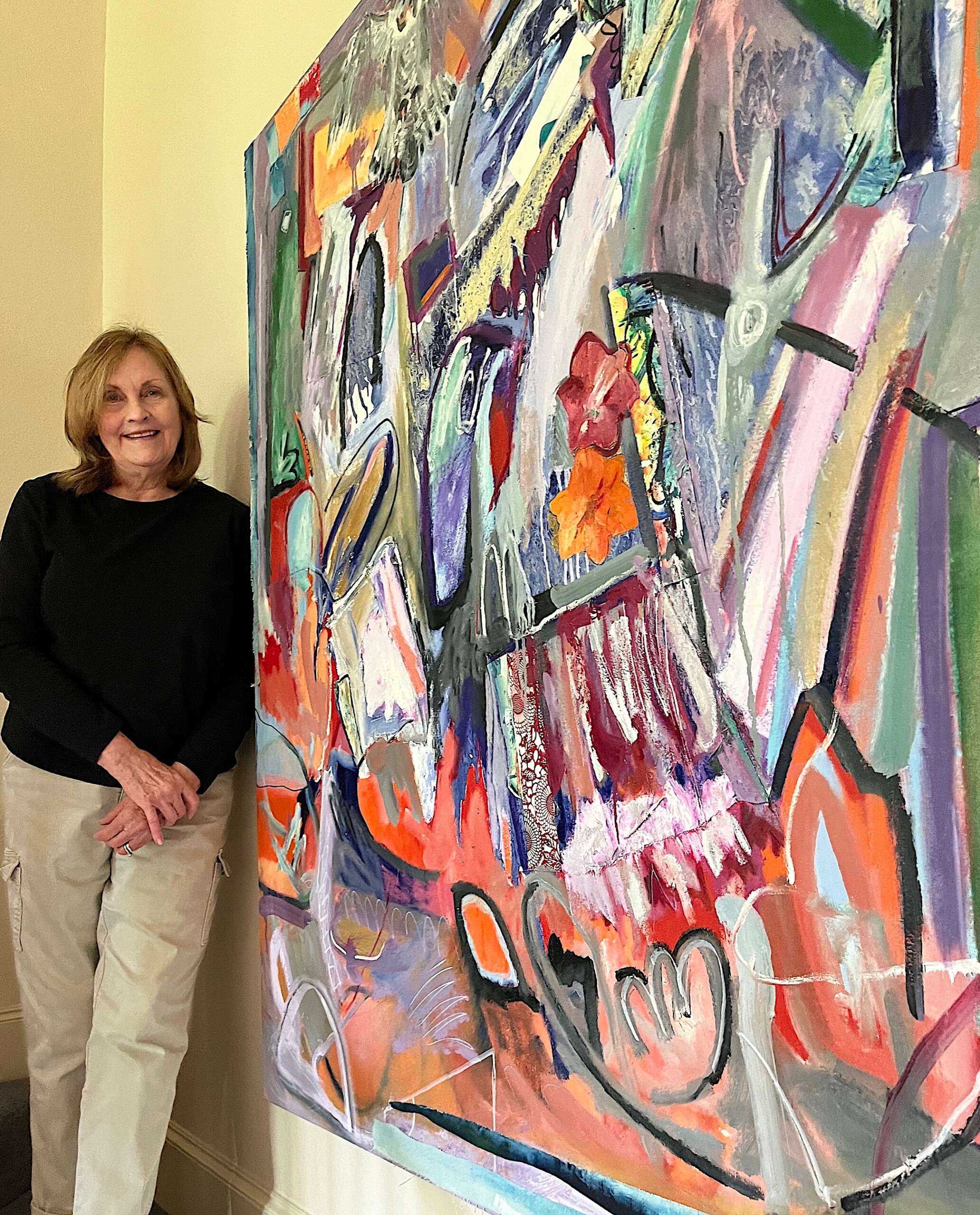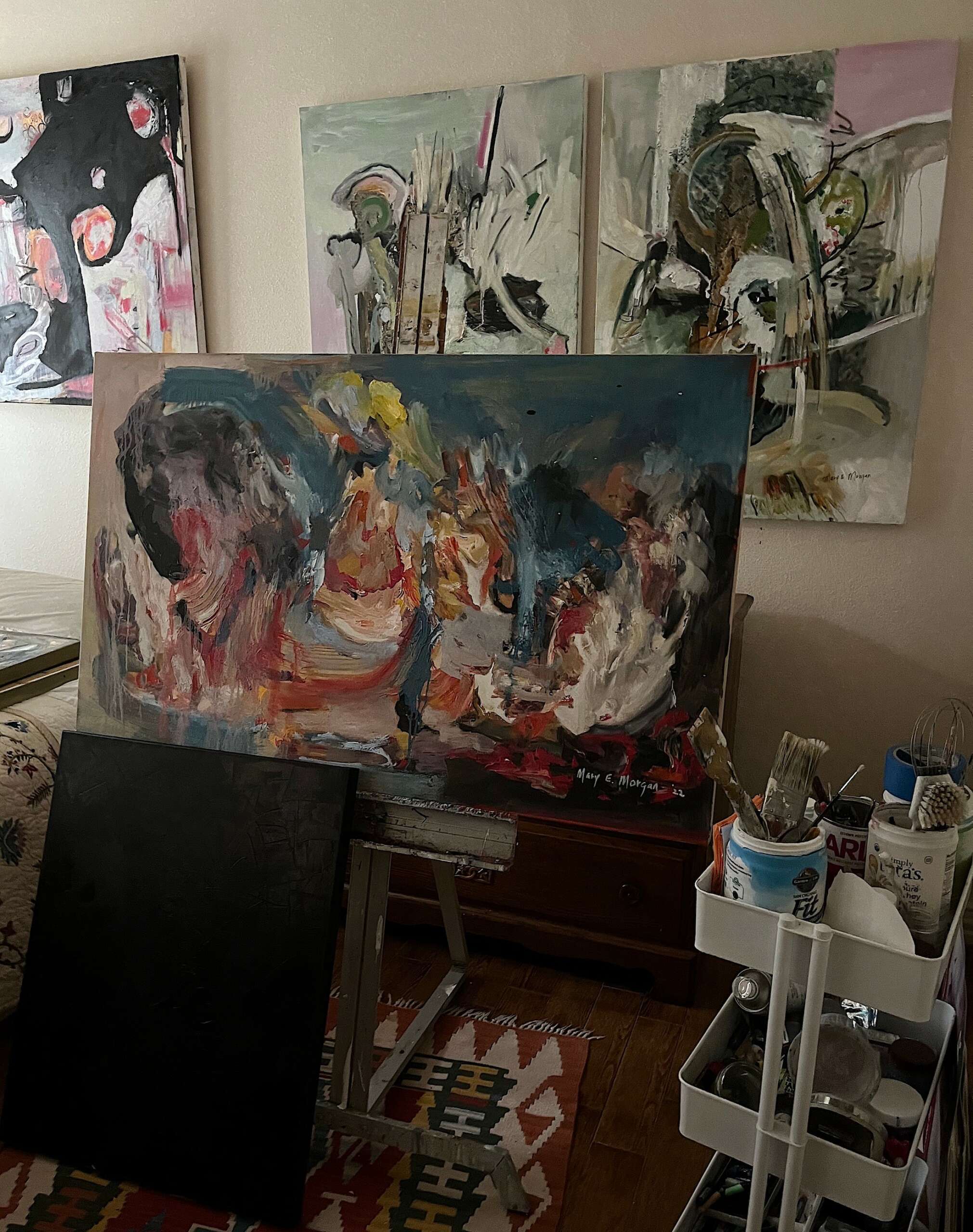We’re excited to introduce you to the always interesting and insightful Mary Morgan. We hope you’ll enjoy our conversation with Mary below.
Mary, thanks for taking the time to share your stories with us today When did you first know you wanted to pursue a creative/artistic path professionally?
I knew after I began teaching art that I wanted to pursue my creative artist path professionally as a painter. Because I was teaching full-time it wasn’t until I began to examine how I was going to attain my goal of becoming a visual artist that the opportunity to return to graduate school became available. Even though it took me seven long years of taking classes, one a semester and every summer I graduated with my MA from Texas Woman’s University in May 2002. It was through the process of graduate school that I learned how much I didn’t know about becoming a painter. I learned how much time it takes to explore and develop my creative mind and skills. After graduate school, I was offered to be the head of an art department in a different private school than where I was teaching. It was a new school and I jumped at the chance to develop the curriculum for the upper school. After I accepted the position and after my first year as Department Chair I also began teaching at a local private university part-time as an adjunct professor. After six years as the department chair of the private school I resigned my position because I wanted to devote more time teaching at the university level. I started teaching five classes in the visual art department as an adjunct professor. Most of my teaching assignments were studio classes in painting. While teaching as an adjunct my schedule was freer to devote more time to painting. Slowly, but surely I was able to work longer spans of time in my home studio and I was also able to spend time researching some of my favorite painters. After I retired completely from teaching in 2016 I was able to find a studio space where I could paint every day. I began to explore and develop a strong painting style from spending ample time in the studio on a consistent basis.


As always, we appreciate you sharing your insights and we’ve got a few more questions for you, but before we get to all of that can you take a minute to introduce yourself and give our readers some of your back background and context?
I am very grateful to tell my story. It began when I was a little child. I remember trying to paint with whatever watercolors I had the sunset just west of my front porch. The large unobstructed sky was my joy and made me feel happy every day. It wasn’t until our family moved to Zurich, Switzerland in the summer of 1967, when I was 17 that I was able to take my first art class. I attended the International School located in Kilchberg,, outside of Zurich. Rhoda Issac was my art teacher and I remember that she told my parents what a “natural sense of color” I had. I was awarded a first-place ribbon at the end of the school year in the juried art show for my “West Texas landscape” painting. When I returned from Europe I enrolled in the local junior college for the fall semester. I didn’t have much confidence in my ability to take an art class, but I never lost interest in the medium and continued to paint at home. After finishing two years of junior college, I enrolled in Baylor University and took my first art class. I was very under confident, but I had a desire to learn more. I worked steadily at the art classes and had enough hours to minor in art with a Physical Education major and a secondary teaching certificate. My first opportunity to teach art was as a substitute art teacher. I found other seasoned art teachers to be helpful since I didn’t know enough. I also tried to take some workshops to pick up ideas and learn skills. I realized that teaching art wasn’t for the lazy teacher and it wasn’t always fun nor enjoyable without first learning how to engage my students. I continued to face the challenges of maintaining a strong and positive atmosphere in the classroom. I wanted my students to love my class. I had three children by the time I was able to teach full-time and my husband, a football coach, was gone a lot with his duties as a coach. My creative spirit kept me alive as I fought to stay active and alert. As the years progressed and the children grew my time was divided by their activities and my desire to study art. Finally, my sons and daughter went off to college, and I finished my Master’s degree I had more time for myself and I felt renewed and encouraged to continue toward my goal of becoming a painter. I loved teaching in the college visual art department and made friends with my other colleagues, who were very encouraging to me. We developed strong ties through our love for teaching and art. I am so grateful for my college teaching years which continued to challenge my teaching skills and knowledge. I discovered how important it was to do the research and to paint whenever I could.
After I retired at the age of sixty-six I still had energy and good health. I painted as often as I could and challenged myself to develop a statement about my artwork.
As I seriously began to observe my paintings I realized that my artwork revolved around “my life’s journey.” Included in my statement is the idea that I am influenced by experiences past and present, my work is a combination of conscious and subconscious thoughts. The subjects of my abstract work relates to the following: nature, my family, events, and my spiritual beliefs and often a combination of these. I usually paint in color but at times I have been challenged to change my pallet into neutral tones. I desire for my artwork to have an emotional impact for the viewer’s pleasure. I hope that something from my soul, that which is intangible, impacts the viewer so that they can decide how to interpret the artwork. I desire not to be prideful because it is God who made me, not myself, he has allowed me the gift of time and creative thought to grow and develop. I am grateful to all the people who take a look at my work. Today, as my work continues to evolve, I hope that as long as I am able, I can enjoy working with my hands. Because I enjoy international travel its been my desire to continue to develop relationships with artists all over the world.
One of the most precious of all my international experiences was the fact that I had a solo show in the summer of 2004 in Taksim, Istanbul, Turkey. I’ll never forget the people who came and even though I do not speak Turkish the artwork found a common language as we enjoyed one another. I want to thank all the artists past and present who have impacted my life.
Kandinsky was the first abstract painter that I studied, whose work and philosophy impacted mine. So many others including all the American Abstract Expressionists’ and some very fine current artists; Cecily Brown, Angel Otero, Eillot Hundley, and Julie Mehretu are a few of my favorites. My new goal is to market my art in different and effective ways. You can always find me on Instagram @maryemorganart or my website www.


Do you think there is something that non-creatives might struggle to understand about your journey as a creative? Maybe you can shed some light?
It has been my experience that people only appreciate what they see or what they know. Often it is necessary to explain that my artwork is more about “what I feel” and at times it can be frustrating to explain what my artwork is about without going into details. I think this is an area that can easily be resolved if people want to know more through avenues of education, art talks, dialog, or open discussions. Making myself available is a way to educate the non-artist or curious people. Avenues for doing may be difficult to find. Some communities provide avenues for arts-talks and some churches are providing creative resources. Social media has been very helpful as well as online galleries for people to see and read about the artist’s work. It will be interesting to see how A-I seeks to resolve some of these issues. Last but not least, there are plenty of books about art history.


What do you find most rewarding about being a creative?
One of the most rewarding experiences is knowing that my artwork appeals to many for various reasons. I like the fact that it has both a global appeal and an audience. If I’m asked to do a commission, although sometimes challenging, it is a great compliment and opportunity. If I sell an artwork, that makes my day. I desire for my artwork to be effective and have longevity. To think that others will view it for generations is probably the most rewarding experience of all.


Contact Info:
- Website: www.marymcdowellmorgan.com
- Instagram: @maryemorganart
- Facebook: Mary E Morgan Art
- Linkedin: Mary Morgan
Image Credits
Barry L. Morgan


